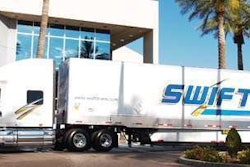 The FlowBelow Tractor AeroKit was first introduced in 2013, and is now available as a factory-installed option on certain new model trucks.
The FlowBelow Tractor AeroKit was first introduced in 2013, and is now available as a factory-installed option on certain new model trucks.Swift Transportation, country’s largest truckload carrier, will outfit approximately 40 percent of its 18,000 truck fleet with FlowBelow’s aerodynamic Tractor AeroKit System next year, the company announced Tuesday.
Swift first tested the Tractor AeroKit in 2014 with an initial SAE fuel efficiency test and later deployed 100 AeroKits into its fleet to further test the product’s durability, ease of use and real-world fleet average fuel efficiency performance.
Bert Kinsel, Swift’s vice president of heavy equipment procurement, says the Tractor AeroKit System offered advantages to the company because it focused aero gains on the truck rather than the trailer.
“Many aerodynamic products for trailers exist today, and we certainly utilize those that work well for us,” he says, “but because we operate over three trailers for every one truck in the fleet – meaning that our trailers are utilized approximately one-third as much as the tractors – the return on an investment for a trailer-mounted technology can take a lot longer than a comparable technology installed on one of our trucks.”
The FlowBelow Tractor AeroKit, which includes four quick-release wheel covers and four fairings strategically placed between and behind the drive wheels of the truck, reduces aerodynamic turbulence and drag around the rotating wheels of the truck.
For trucks traveling above 40 mph, FlowBelow says the system is effective at lowering drag, which means less horsepower is required to move the vehicle, and in-turn leads to improved fuel efficiency.
Citing multiple third party tests, FlowBelow claims the Tractor AeroKit is verified to provide fuel savings of up to a 2.23 percent.










